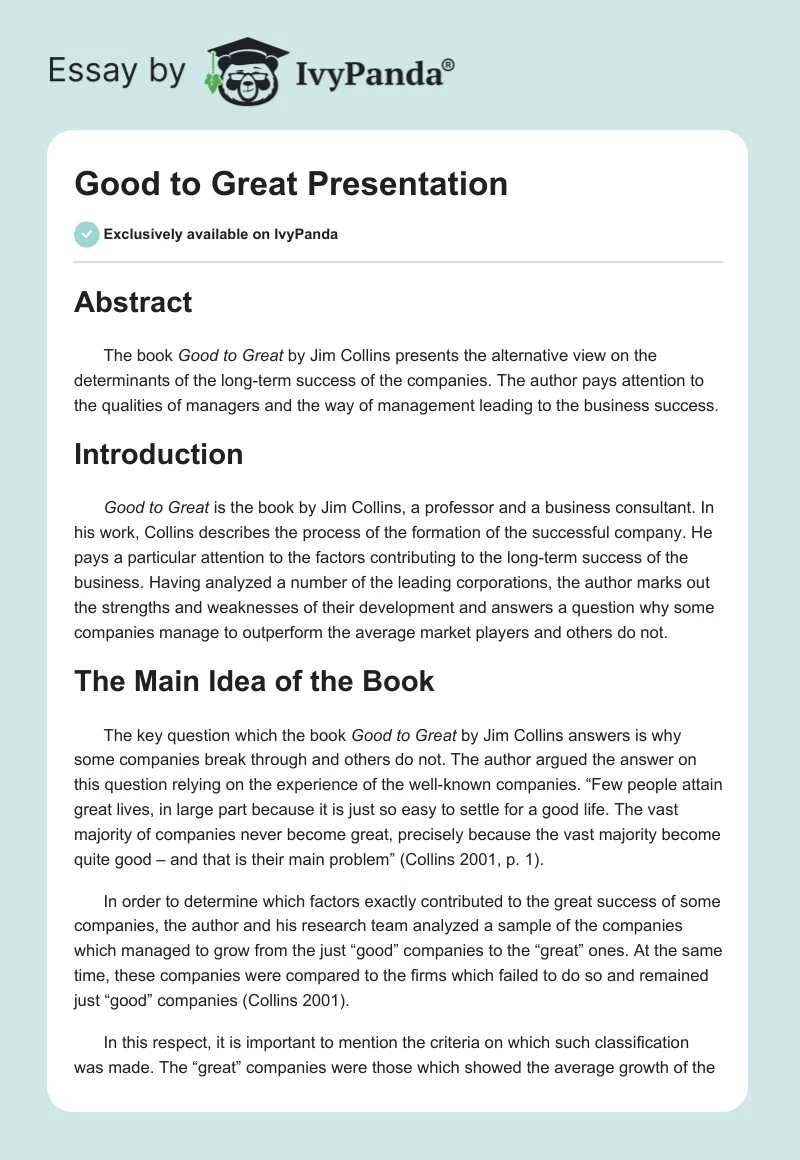Abstract
The book Good to Great by Jim Collins presents the alternative view on the determinants of the long-term success of the companies. The author pays attention to the qualities of managers and the way of management leading to the business success.
Introduction
Good to Great is the book by Jim Collins, a professor and a business consultant. In his work, Collins describes the process of the formation of the successful company. He pays a particular attention to the factors contributing to the long-term success of the business. Having analyzed a number of the leading corporations, the author marks out the strengths and weaknesses of their development and answers a question why some companies manage to outperform the average market players and others do not.
The Main Idea of the Book
The key question which the book Good to Great by Jim Collins answers is why some companies break through and others do not. The author argued the answer on this question relying on the experience of the well-known companies. “Few people attain great lives, in large part because it is just so easy to settle for a good life. The vast majority of companies never become great, precisely because the vast majority become quite good – and that is their main problem” (Collins 2001, p. 1).
In order to determine which factors exactly contributed to the great success of some companies, the author and his research team analyzed a sample of the companies which managed to grow from the just “good” companies to the “great” ones. At the same time, these companies were compared to the firms which failed to do so and remained just “good” companies (Collins 2001).
In this respect, it is important to mention the criteria on which such classification was made. The “great” companies were those which showed the average growth of the earnings per share 6.9 times more, on average, than the same ratio which the other companies showed during the period of 15 years (Collins 2001).
The author gives a list of companies which have managed to outperform the market on the ratios of long-term growth. The following companies have been included in the list: Abbott, Circuit City, Fannie Mae, Gillette, Kimberly-Clark, Kroger, Nucor, Phillip Morris, Pitney Bowes, Wal greens, and Wells Fargo (Collins 2001).
In contrast, the following companies have been chosen as the respective examples of firms which have not managed to transform from the “good” to “great”: Upjohn, Silo, Great Western, Warner-Lambert, Scott Paper, A&P, Bethlehem Steel, RJ Reynolds, Addressograph, Eckerd, and Bank of America (Collins 2001).
It is interesting to note that the author stresses that the strategy is not the primary determinant of the companies’ breakthrough (Collins 2001). The compared companies from both groups have had a well-defined strategic plan.
One of the key points which is indicated in the book is that the “great” companies have not focused on what they should do but rather what they should not (Collins 2001). And that is the most important point making them different from the companies which have failed to become “great”.
In the model of the transformation from the “good” to “great”, the author emphasizes three crucial factors. They are the disciplined managers, the disciplined thinking, and the disciplined actions (Collins 2001). The first factor means that the truly great managers aim at achieving not the personal success but the success of the business they manage.
Furthermore, the author emphasizes such qualities of the true leaders as the modesty and professional will (Collins 2001). The second one means the taking into account of the real facts (Collins 2001). The “great” companies have faced the facts and those companies which remain just “good” have not. The third factor means the use of the strict discipline to develop the spirit of the entrepreneurship and creativity within the organization.
The Evaluation of the Book
The book Good to Great by Jim Collins is considered to be one of the best works on management of the last decades. “This nearly 300-page book is packed with leading edge thinking, clear examples, and data to support the conclusions” (Reh n.d.).
However, the critics also indicate to the weak points of the book including the survivorship bias and the lack of the if-scenario analysis. In particular, The Economist mentioned that the analysis presented in the book was made before the financial crisis and the author did not take into consideration the affect of the economic downturn on the analyzed companies (“Good to great” 2009).
In my opinion, Good to Great by Jim Collins is very interesting work. It presents an alternative view on the long-term success of the companies. Undoubtedly, the arguments given by the author deserve special attention. I think this book will be useful for the wide range of readers including the students majoring in management, professors, consultants, managers, entrepreneurs, and everyone who is interested in the topic.
Conclusion
Good to Great by Jim Collins is one of the modern bestsellers in the niche of the specialized literature. The book presents the results of the analysis of the number of large companies which have managed to outperform the market and to break through as well as those companies which have not.
The author emphasizes the three major factors contributing to the long-term success of the companies: the disciplined managers, the disciplined thinking, and the disciplined actions. The book is rather interesting and is worthy for reading to everyone who is interested in the topic.
References
Collins, J. (2001). Good to Great. New York, USA: HarperCollins Publishers.
Good to great to gone. (2009). The Economist. Web.
Reh, J. F. (n.d.). Good To Great: Why Some Companies Make The Leap…and Other’s Don’t. Web.


